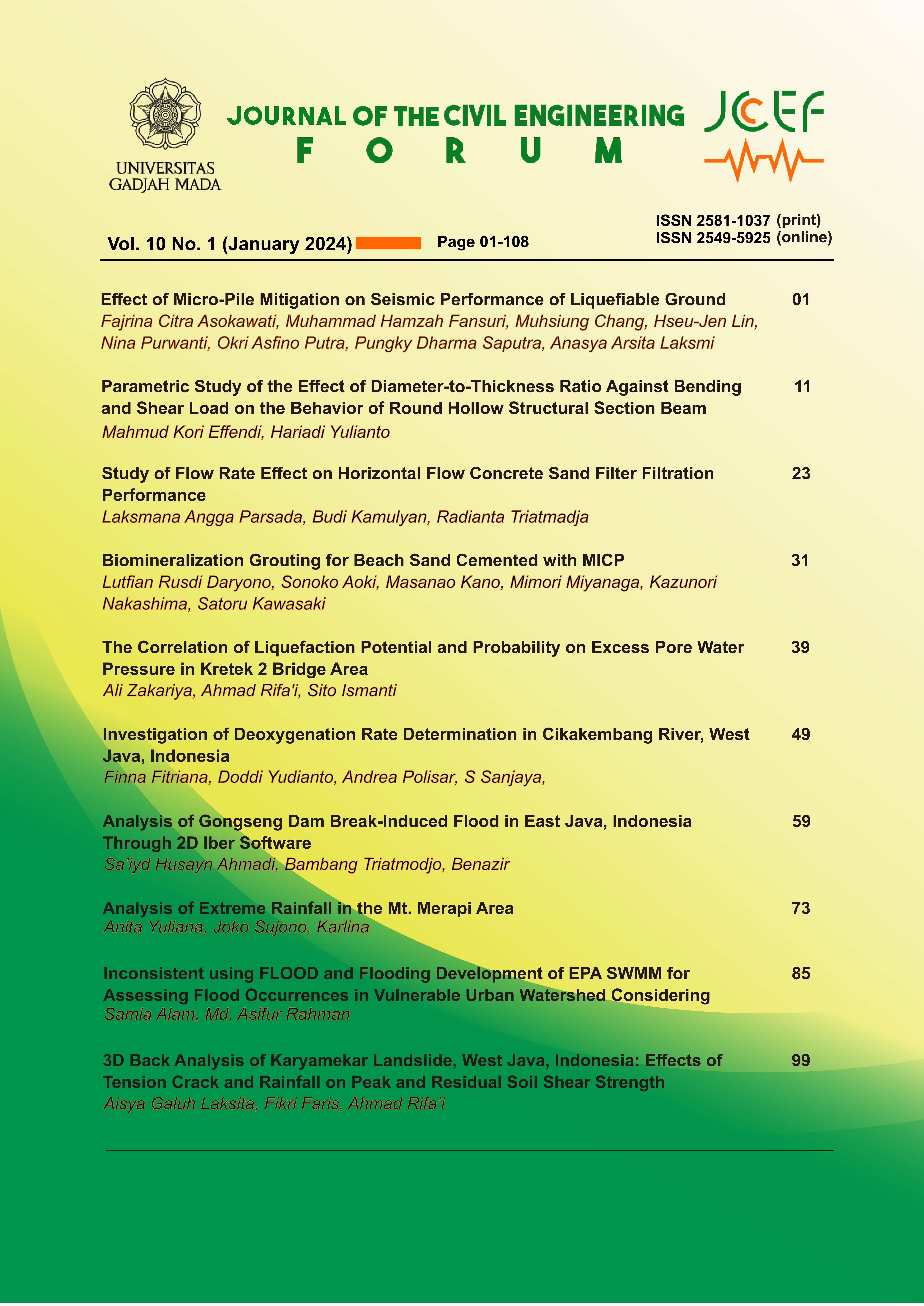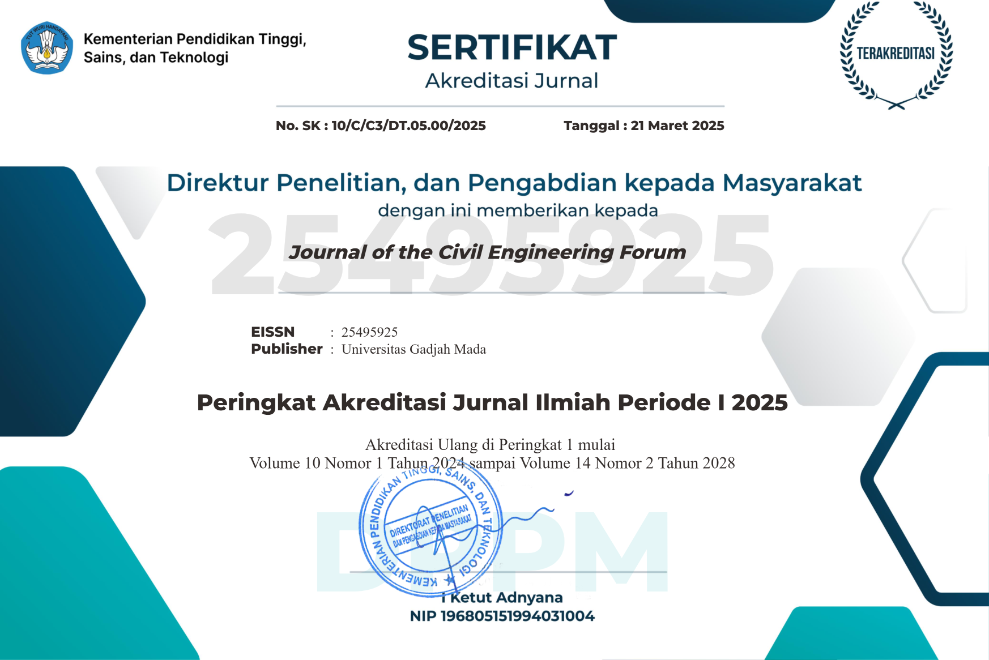The Correlation of Liquefaction Potential and Probability on Excess Pore Water Pressure in Kretek 2 Bridge Area
Abstract
Liquefaction is soil condition associated with the drastic increase in pore water pressure of uniform sandy soil due to an enormous earthquake. Therefore, this study aimed to investigate the correlation of liquefaction potential with excess pore water pressure ratio in nine boreholes located at Kretek 2 Bridge area using empirical and numerical methods. Liquefaction potential was estimated based on a semi-empirical method simplified by Idriss and Boulanger (2008), and safety factor (SF) value of <1.0 was used to represent the existence of its potential. The result showed that liquefaction potential was dominant at depths of 1.5 to 6.0 m, with the exception of BH-9 with 16.5 m and BH-4. Furthermore, the excess pore water pressure ratio was estimated using empirical method developed by Yegian and Vitelli (1981) as well as Serafini and Perlea (2010). Numerical analysis was also conducted for comparison purposes and the process focused on using Deepsoil v7.0 to generate excess pore water pressure by considering soil conditions and dominant seismic sources in Kretek 2 Bridge area. The result showed that the ratio of excess pore water pressure was greater or equaled 0.8. Both empirical and numerical methods produced similar values for BH-1, BH-2, BH-8, and BH-9 at a depth of 1.5–3.0 m, 3–4.5 m, 3.0 m, and 16.5 m, respectively. This showed a correlation between excess pore water pressure ratio and liquefaction potential values at the same depth. However, numerical method tended to overestimate the ru value, necessitating the use of empirical method to obtain a more reliable result.
References
BAPPENAS (2006), ‘Preliminary damage and loss assessment Yogyakarta and Central Java natural disaster’.
Buana, T. and Agung, M. (2015), Liquefaction characteristic based on ground response linier equivalent analysis and cyclic stress concept on young Merapi volcanic deposit in Bantul, in ‘10th Asian Regional Conference of IAEG’, pp. 1–5.
Google Earth (2023), ‘Citra satelit google earth titik bor penyelidikan tanah jembatan kretek 2’. https://earth.google.com/web/.
Hashash, Y., Musgrove, M., Harmon, J., Ilhan, O., Xing, G., Numanoglu, O., Groholski, D., Phillips, C. and Park, D. (2020), DeepSOIL V 7.0-User Manual, Board of Trustees of the University of Illinois at Urbana-Champaign, Urbana, IL.
Hazirbaba, K. (2005), Pore Pressure Generation Characteristics of Sands and Silty Sands: A Strain Approach, Ph.D. dissertation.
Idriss, I. (1999), An update of the seed-idriss simplified procedure for evaluating liquefaction potential, in ‘Transportation Research Board ’99 Workshop New Approaches to Liquefaction Analysis’, Washington, DC, pp. 37–52.
Idriss, I. and Boulanger, R. (2004), ‘Evaluating the potential for liquefaction or cyclic failure of silts and clays’, Neurosci. Lett. 339, 123–126.
Idriss, I. and Boulanger, R. (2008), ‘Soil liquefaction during earthquakes’, Mach. Prod. Eng. 160, 43.
Iwasaki, T., Tokida, K. and Tatsuoka, F. (1981), Soil liquefaction potential evaluation with use of the simplified procedure, in ‘International Conferences on Recent Advances in Geotechnical Earthquake Engineering and Soil Dynamics’, Vol. 12, pp. 209–214.
Jalil, A., Fathani, T., Satyarno, I. and Wilopo, W. (2021), Nonlinear site response analysis approach to investigate the effect of pore water pressure on liquefaction in palu, in ‘IOP Conference Series: Earth and Environmental Science’.
Look, B. (2007), Handbook of Geotechnical Investigation and Design Tables, Taylor & Francis Group, London.
Marcuson, W. and Hynes, M. (1990), Stability of Slopes and Embankments during Earthquakes.
Mase, L. (2017a), ‘Experimental liquefaction study of Southern Yogyakarta using shaking table’, J. Tek. Sipil ITB 24, 11–18.
Mase, L. (2017b), ‘Liquefaction potential analysis along coastal area of bengkulu province due to the 2007 mw 8.6 Bengkulu earthquake’, J. Eng. Technol. Sci. 49, 721–736.
Mase, L., Fathani, T. and Adi, A. (2021), ‘A simple shaking table test to measure the liquefaction potential of Prambanan area, Yogyakarta, Indonesia’, ASEAN Eng. J. 11, 89–108. https://doi.org/10.11113/AEJ.V11.16874.
Mase, L., Tanapalungkorn, W., Likitlersuang, S., Ueda, K. and Tobita, T. (2022), ‘Liquefaction analysis of Izumio sands under variation of ground motions during a strong earthquake in Osaka, Japan’, Soils Found. 62, 101218. https://doi.org/10.1016/j.sandf.2022.101218.
Port and Harbour Research Institute (1997), Handbook on Liquefaction Remediation of Reclaimed Land, A.A. Balkema, Rotterdam.
Prakoso, W., Mazaya, D. and Kartika, R. (2022), ‘Pore pressure responses of liquefied numerical sand columns’, J. Civ. Eng. Forum 8, 225–236. https://doi.org/10.22146/jcef.3395.
Pramaditya, A. and Fathani, T. (2020), ‘Physical modelling of earthquake-induced liquefaction on uniform soil deposit and settlement of earth structures’, J. Civ. Eng. Forum 1000, 85–96. https://doi.org/10.22146/jcef.59467.
Rahardjo, W., Sukandarrumidi and Rosidi, H. (1977), Geologic map of the Yogyakarta quadrangle, Java, Technical report, Direktorat Geologi, Departemen Pertambangan, Republik Indonesia, Bandung.
Seed, H. and Idriss, I. (1970), A simplified procedure for evaluating soil liquefaction potential, Technical report, University of California, California.
Serafini, D. and Perlea, V. (2010), Comparison of liquefaction triggering analysis approaches for an embankment dam and foundation, in ‘The 5th International Conference on Recent Advances in Geotechnical Earthquake Engineering and Soil Dynamics’, Missouri University of Science and Technology, San Diego, California.
Soebowo, E., Tohari, A. and Sarah, D. (2009), ‘Potensi likuifaksi akibat gempabumi berdasarkan data CPT dan N-SPT di daerah Patalan Bantul, Yogyakarta’, J. Ris. Geol. dan Pertamb. 19, 85. https://doi.org/10.14203/risetgeotam2009.v19.25.
Supartoyo (2006), ‘Gempabumi yogyakarta tanggal 27 Mei 2006’, Bul. Berk. Merapi 3, 36–55.
Yegian, M. and Vitelli, B. (1981), Analysis for liquefaction: Empirical approach, in ‘Int. Conf. Recent Adv. Geotech. Earthq. Eng. Soil Dyn.’, pp. 1–6.
Youd, T. and Perkins, D. (1978), ‘Mapping liquefaction-induced ground failure potential’, ASCE J Geotech Eng Div 104, 433–446. https://doi.org/10.1061/ajgeb6.0000612.
Zakariya et al. (2022a), Ground motion and liquefaction study at Opak river estuary Bantul, in ‘5th International Conference on Earthquake Engineering and Disaster Mitigation’, Universitas Gadjah Mada, Yogyakarta. https://doi.org/10.1088/1755-1315/1244/1/012032.
Zakariya et al. (2022b), ‘Quantitative and qualitative analysis of liquefaction potential in medium-dense sandy soil area near Opak fault’, J. Jalan Jembatan 39, 74–87.
Copyright (c) 2024 The Author(s)

This work is licensed under a Creative Commons Attribution-ShareAlike 4.0 International License.
Copyright is granted to authors for the purpose of providing protection for articles written to describe experiments and their results. JCEF will protect and defend the work and reputation of the author and are also willing to address any allegations of violation, plagiarism, fraud, etc. against articles written and published by JCEF. JCEF is published under the terms of the Creative Commons Attribution-ShareAlike 4.0 International License (CC BY-SA 4.0). The author holds the copyright and assigns the journal rights to the first publication (online and print) of the work simultaneously.







